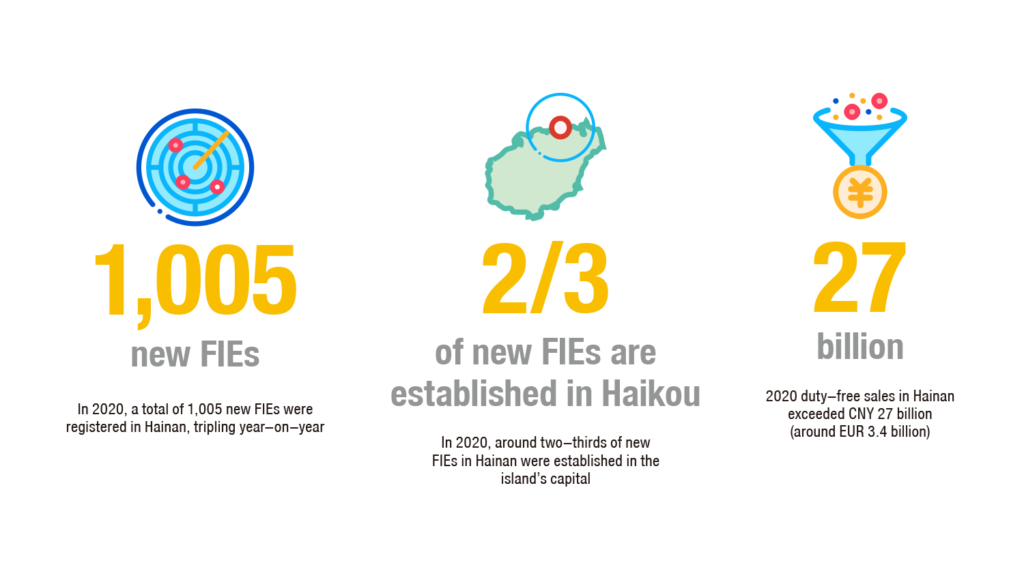
An intersection point for China’s dual circulation policy
Since first being announced in April 2018, and the publication of theMasterplan for the Construction of the Hainan Free Trade Port (Hainan FTP Masterplan) in June 2020, the Hainan FTP is now fully operational and has already become the most open region in China for foreign investment. This article by Alessio Petino of the EU SME Centre looks at the state of play, opportunities and outlook for European investors and SMEs in China’s largest free trade area.
———————
China’s 14th Five-year Plan (2021–2025) will be key for the Hainan FTP. By 2025, the Hainan FTP should have established all conditions necessary for further relaxing ‘first-line’—foreign imports in Hainan—customs procedures, while controlling its ‘second-line’ ones – foreign goods exported from Hainan to the mainland. In fact, the Hainan FTP is considered a main pillar of China’s ‘dual circulation’ strategy: to quote regional Party Secretary Shen Xiaoming, “if ‘dual circulation’ can be pictured as a number ‘8’, then the Hainan FTP is the intersection point of the two circles”.[1]
Attractive customs policies, increased market access, cross-border movement facilitation (of people, capital and data) and tax incentives will attract foreign goods, services and talent. The island is also located in a strategic position along the Maritime Belt and Road, is a key hub of the New International Land-Sea Corridor, and is at the heart of the Asia-Pacific region, which recently witnessed the signing of the Regional Comprehensive Economic Partnership free trade agreement.”
Nonetheless, the fundamental purpose of the Hainan FTP is to use ‘external’ (international) circulation predominantly to serve the ‘internal’ (domestic) circulation:
- Offshore duty-free shops mean that Chinese consumers can spend in China what they used to spend abroad.
- Top-notch education institutions (mostly foreign but also domestic such as Shanghai Jiaotong and Zhejiang University) and medical tourism mean that Chinese citizens do not need to travel abroad anymore to access such high-level services.
- Tax exemption policies will be applied to manufactured goods, components and auxiliary materials that China considers a priority, thus providing impetus to Chinese supply-side structural reforms and industrial upgrading.
- The three high-technology sectors at the core of the Hainan FTP—seeds, deep-sea and aerospace—support China’s ambitions in key strategic and frontier fields, matching three of the country’s 15 national science-technology megaprojects.
- Strong incentives and support policies aim to attract foreign investors to locate their regional headquarters on the island, and follow their mainland China or even APAC operations from there.
- Finally, the Hainan FTP is expected to become deeply integrated with other domestic initiatives in the region, such as the Greater Bay Area and the Shenzhen Special Economic Zone.
The above suggests that, although European businesses can benefit from expanding opportunities in the short/medium-term, over the long-term they will face increasingly sustained competition from domestic actors whose cultivation they contributed to.

Overview of foreign investment flows in Hainan FTP
Official statistics confirm that there has been significant growth of foreign investmentin the island. In 2020, a total of 1,005 new foreign-invested enterprises (FIEs) were registered in Hainan, tripling year-on-year; among these, 855 were registered in the second half of the year, that is, after the publication of the FTP Masterplan.[2] To put things in perspective, the number of FIEs registered in Hainan in 2020 alone accounts for half of all registered there over the last ten years. FIEs signing up include Fortune Global 500 companies and entities from the European Union (EU) such as EDF, Schneider Electric, TUI Group, KWS and OTP Bank Group. Other major investment agreements involve multinationals from other regions such as Tesla, General Electric, ITOCHU Corporation and Roc Oil. Many other companies—especially in the healthcare sector—though not yet establishing official branches, are recruiting on-the-ground teams to develop their business on the island.
Top locations in Hainan
Haikou is the top destination for foreign investment. Official figures show that in 2020, around two-thirds of new FIEs in Hainan were established in the island’s capital. In Haikou’s Window to Global Trade complex in the central business district, one-fifth of newly-registered companies are FIEs (from 32 countries, including five EU Member States). [3] Haikou’s key advantage is its expanding logistics network, formed by Haikou Meilan International Airport—which has launched intercontinental air freight routes, including to Amsterdam—and Haikou Port. Haikou is also home to four of the 11 key industrial parks at the core of the Hainan FTP, and is well connected to others such as the Yangpu Economic Development Zone, the Wenchang International Aerospace City and the Hainan Ecology Software Park.
Sanya is the second most popular destination for foreign investment in the island. In 2020, 158 new FIEs were registered in Sanya (up 163 per cent on 2019), including Yum! and the Rio Tinto Group.[4] The last year saw a surge of investment from countries outside the region such as the United States, the United Kingdom and Japan. Sanya’s main strengths relate to tourism and cultural industries, but the newly-established Yazhou Bay Sci-Tech City is also starting to attract investors in the information and communication technology (ICT) sector.
Another key area to monitor closely is the Bo’ao Lecheng International Medical Tourism Pilot Zone, located on the eastern side of the island and home to the annual Bo’ao Forum for Asia. The aim of the zone is to become a key destination for medical tourism; several Chinese medical and pharma groups have already established branches there.
Finally, it is noteworthy that almost half (43 per cent) of new FIEs on the island in 2020 were established within Hainan FTP’s 11 key industrial parks, the top three by number being the Haikou Jiangdong New District, the Haikou Fullsing Internet Industry Park and the Hainan Ecology Software Park.
What about foreign SMEs?
The figures above show that foreign investment flows into the Hainan FTP come from large organisations. Indeed, nearly all investment promotion activities carried out by local government agencies are directed at large multinationals, Fortune Global 500 companies or foreign government representations and trade missions. Chinese domestic giants are also key targets: many have already signed investment contracts, including state-owned enterprises like China Telecom, Sinochem, Sinopharm and Shanghai Electric; but also private market giants like Xiaomi, Huawei, Alibaba and Midea.
It is very hard to find any mention of foreign-invested SMEs in official documents. This highlights the clear focus of the Hainan FTP on big names and numbers in the short-term – and the image that it wants to communicate. It is also noteworthy that several foreign SMEs’ applications to participate in the first China International Consumer Products Expo(7th to 10th May 2021 in Haikou) were rejected.
Nonetheless, the Hainan FTP still offers attractive opportunities to European SMEs, especially in the short/medium-term. In addition to the more relaxed market entry requirements for key sectors such as healthcare, education, telecommunications and professional services, European producers of consumer goods (many of which are or will be exempted from import duties) may find lucrative opportunities in the numerous tourism resorts or offshore duty-free shops being opened in Haikou, Sanya and Bo’ao. It is noteworthy that 2020 duty-free sales in Hainan exceeded Chinese yuan (CNY) 27 billion (around euro (EUR) 3.4 billion)—more than twice 2019 figures—and are expected to exceed CNY 150 billion by the end of the 14th Five-year Plan period.[5]
There are also opportunities for European producers of key components, raw and auxiliary materials, to export their goods (duty-free) to Hainan-based manufacturers in the machinery, aviation and ICT sector. Finally, European SMEs that locate their operational headquarters in Hainan will be able to expand their business networks across the rest of mainland China, while at the same time enjoying the reduced 15 per cent corporate income tax rate as well as the many other supportive policies.
Our advice to European SMEs is to start testing the waters in Hainan, establishing potential contacts with local partners, but maintain an observant and careful position until the ‘Hainan frenzy’ pumped up by media gives way to tangible results – especially after the first Hainan Expo.
Alessio Petino is the Knowledge Coordinator of the EU SME Centre, where he supervises industry reports, training activities and technical assistance provided to European SMEs. Since the publication of the Hainan FTP Masterplan, Alessio has been following closely the developments of the Hainan Free Trade Port, and also undertook two field visits to Haikou to meet with local investment promotion officers. More information and updates on the Hainan Expo, and on the EU SME Centre’s free-of-charge services, can be found at www.eusmecentre.org.cn.
[1] Economy conference of Provincial Party Committee: Hainan economy – what does the future look like and how to get there (link in Chinese), Hainan Provincial Committee website, 31st December 2020, viewed 3rd March 2021, <http://www.hainanpc.net/eportal/ui?pageId=2132&articleKey=1005585&columnId=1956>
[2] Recap of province-wide utilisation of foreign investment in 2020 and the last three years (link in Chinese), Department of Commerce Hainan website, 21st January 2021, viewed 3rd March 2021, <https://dofcom.hainan.gov.cn/dofcom/zwdt/202101/7270d91f18084f4ea2ecc86aefdbbae4.shtml>
[3] https://finance.sina.com.cn/tech/2021-01-06/doc-iiznctkf0409744.shtml. It is noteworthy that the complex aims to become an international platform for SME cooperation, thanks to various one-stop services for company registration and operations provided within just a few working days.
[4] http://www.hainan.gov.cn/hainan/zsyz/202101/056f8b10b71d45a890306475fcb1c437.shtml.
[5] http://hainan.sina.com.cn/news/hnyw/2021-01-04/detail-iiznezxt0424936.shtml


Recent Comments